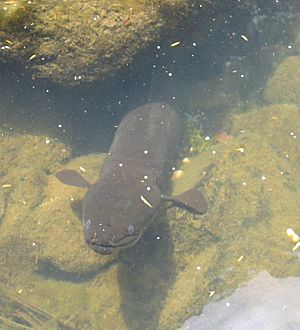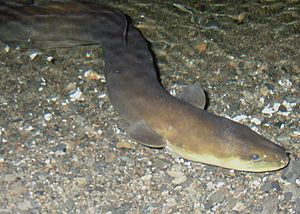New Zealand longfin eel facts for kids
Quick facts for kids New Zealand longfin eelMāori: tuna |
|
|---|---|
 |
|
| New Zealand longfin eel at the base of a waterfall near Piha beach, Waitākere Ranges, Auckland. |
|
| Conservation status | |
 Gradual Decline (NZ TCS) |
|
| Scientific classification | |
| Genus: |
Anguilla
|
| Species: |
dieffenbachii
|
The New Zealand longfin eel (Anguilla dieffenbachii) is a special type of freshwater eel. It lives only in New Zealand, meaning it is endemic there. This eel is the biggest freshwater eel in New Zealand. It is also the only eel species that is found nowhere else in the world.
Other eels in New Zealand include the native shortfin eel, which also lives in Australia. There is also the Australian longfin eel, which came to New Zealand naturally. Longfin eels live for a very long time. They travel all the way to the Pacific Ocean near Tonga to breed. This happens at the end of their lives. Young longfin eels are great climbers. This helps them reach streams and lakes far inland. These eels were an important traditional food for Māori. Today, longfin eels are facing threats and their numbers are going down. However, people still fish for them.
Contents
What do longfin eels look like?
It is easy to tell a longfin eel apart by its fins. Its dorsal (top) fin is about two-thirds the length of its body. This fin starts much closer to the head than its anal (bottom) fin. The shortfin eel has fins that are about the same length.
When a longfin eel bends, its loose skin wrinkles in a special way. A shortfin eel's skin stays smooth when it bends. Also, a longfin eel's mouth goes past its eyes. A shortfin eel's mouth does not go that far.
Size and age
Female longfin eels are usually bigger and live longer than males. Male eels are about 66.6 centimeters long on average. They can grow up to 73.5 centimeters. Their average age is 23 years, but they can live from 12 to 35 years.
Female eels are much larger. They can be from 73 to 156 centimeters long. Their average length is 115 centimeters. Females can live from 20 to 60 years. After this, they travel to the sea to breed. Eels in the North Island breed at a younger age. This means they have new generations faster.
It is hard to tell if a longfin eel is male or female. Their sexual organs do not fully develop until they are over 45 centimeters long. Scientists can only tell their sex by looking inside them. It becomes easy to tell only when the eels are mature and ready to migrate.
Longfin eel life cycle
Longfin eels have a very interesting life cycle. They grow up in fresh water. Then, they become adults and are ready to breed. After that, they travel to the sea to lay their eggs. This way of breeding is called catadromous. It helps mix up the genes of the eels. This creates a healthy population.

New Zealand longfin eels live for a very long time. Some females have been recorded living for 106 years. They can also weigh up to 24 kilograms. They grow very slowly, only about 1–2 centimeters each year. This is the slowest growth rate of any eel species studied.
The life cycle of longfin eels is quite complex. It has four different stages. For many years, scientists did not fully understand it. Even now, there are still some mysteries.
Breeding journey
New Zealand longfins breed only once in their lives. They make a journey of thousands of kilometers. They travel from New Zealand to their breeding areas near Tonga. Each female eel can produce between 1 and 20 million eggs. These eggs are fertilized in a way that is not fully known. It probably happens in deep tropical waters.
After breeding, the adult eels die. Their eggs float to the surface and hatch. They turn into very flat, leaf-like larvae. These larvae are called leptocephalus. They then float along large ocean currents back to New Zealand. This journey can take up to 15 months. Scientists have never found the eggs or larvae of longfin eels.
When the larvae arrive in New Zealand, they change. This change is called metamorphosis. They become glass eels. These are small, clear eels that look like tiny adults. They live in estuaries for their first year. During this time, they get their color. Then they become elvers. Elvers look like small adult longfin eels. These elvers then swim upstream into rivers. There, they grow into adult eels.
What do longfin eels eat?
Longfin eels eat many different things. They are omnivores. This means they eat both plants and animals. They also eat whatever they can find. When they are small, they mostly eat insect larvae. As they get bigger, they also eat a lot of fish. This includes galaxiids and trout. There are even stories of these eels eating water birds.
Where do longfin eels live?
The New Zealand longfin eel lives only in New Zealand. It is found in many lakes and rivers across the country. This includes the Chatham Islands.
Longfin eels can be found very far inland. Some have been found up to 361 kilometers from the sea. They live in fresh waterways and high country lakes that are connected to the ocean. Young eels, called elvers, are amazing climbers. This helps them get far inland. Elvers are under 12 centimeters long.
These climbing trips often happen when the water is warmer. They also happen when the water flow is strong and it is dark. Elvers can travel up to 130 kilometers inland in one summer. They have even been seen climbing almost straight up surfaces that are 43 meters tall! They do this by using surface tension (how water sticks to things) and friction.
Where longfin eels live in a waterway depends on their age. Young eels like shallow water, less than 0.5 meters deep. They prefer areas with rough ground and faster water flow. Adult longfin eels often live next to or under large pieces of debris. They also like to hide under river banks that have been worn away by the water.
Importance for Māori people
Longfin eels have always been an important traditional food for Māori. Māori people have a lot of knowledge about these eels. They know when the eels travel upstream and downstream.
Commercial fishing of longfin eels
People started fishing for longfin eels for money in the 1960s. By the 1970s, about 2000 tonnes of eels were caught each year. But the amount of eels caught started to go down in the early 1980s. In the 2000–2001 fishing season, only 1079 tonnes were caught.
To help manage the fishing, longfin eels were added to the Quota Management System (QMS) in 2000 for the South Island and 2004 for the North Island. This system sets rules for how many eels can be caught. It also sets limits on their size. Eels caught must be between 220 grams and 4 kilograms. Māori people have a special share of 20 percent of the eels that can be caught. It is not allowed to catch and export young glass eels from New Zealand.
Conservation efforts
The Department of Conservation says the New Zealand longfin eel is "At Risk: Declining." This means their numbers are going down.
Scientists and groups that protect nature are worried about these eels. People can still legally fish for them. Also, they reproduce very slowly, only once at the end of their lives. In 2003, a scientist thought their numbers might drop by 5 to 30 percent in the next ten years.
In 2012, there was news that some pet food companies were using these threatened eels in their products. This made conservationists very upset.
Images for kids
See also
 In Spanish: Anguilla dieffenbachii para niños
In Spanish: Anguilla dieffenbachii para niños



